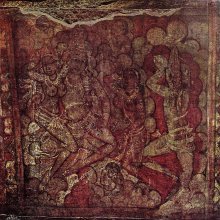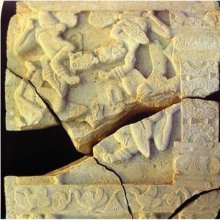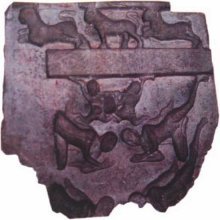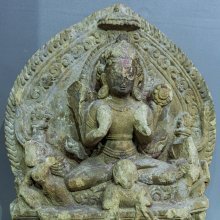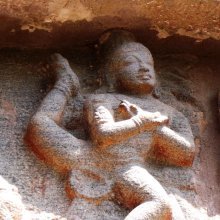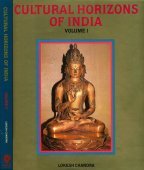Flying: 5 definitions
Introduction:
Flying means something in Buddhism, Pali, Hinduism, Sanskrit, Jainism, Prakrit, the history of ancient India. If you want to know the exact meaning, history, etymology or English translation of this term then check out the descriptions on this page. Add your comment or reference to a book if you want to contribute to this summary article.
Images (photo gallery)
(+6 more images available)
In Hinduism
Yoga (school of philosophy)
Source: ORA: Amanaska (king of all yogas): A Critical Edition and Annotated Translation by Jason BirchFlying refers to one of the various signs and paranormal powers (siddhi) experienced by the Yoga practicioner, according to the Amanaska Yoga treatise (presented in the form of a dialogue between Īśvara and Vāmadeva).—The last fifty-two verses of the Amanaska’s first chapter describe a temporal sequence of psychosomatic signs and paranormal powers (siddhi) brought about by absorption (laya). It begins with one moment, concludes with twenty-four years and consists of forty-seven intervals. [...] It informs practitioners of the initial experiences they may have while immersed in absorption [e.g., Flying], and thus provides them with some idea of their progress in the practice, [...].

Yoga is originally considered a branch of Hindu philosophy (astika), but both ancient and modern Yoga combine the physical, mental and spiritual. Yoga teaches various physical techniques also known as āsanas (postures), used for various purposes (eg., meditation, contemplation, relaxation).
Shaktism (Shakta philosophy)
Source: Google books: Genesis and Development of Tantra (Shaktism)Flying is denoted by the Sanskrit term Khecaratva and represents one of the various Supernatural Powers (siddhi) according to the Siddhayogeśvarīmata: an ancient Sanskrit text devoted to cults of Goddesses as the Vidyāpīṭha or Vidyā Corpus.—In the Siddhayogeśvarīmata, the objectives of rituals are classified as siddhis [e.g., flying (khecaratva)]. They belong to the category of supernatural phenomena and seem to be considerably different from the types of wish people expected to gain from the Vedic rituals that still remained within the sphere of everyday life.

Shakta (शाक्त, śākta) or Shaktism (śāktism) represents a tradition of Hinduism where the Goddess (Devi) is revered and worshipped. Shakta literature includes a range of scriptures, including various Agamas and Tantras, although its roots may be traced back to the Vedas.
In Buddhism
Tibetan Buddhism (Vajrayana or tantric Buddhism)
Source: Google Books: The Crystal Mirror of Philosophical SystemsFlying refers to one of the “Eight Yogic Achievements” (in Tibetan: dngos grub brgyad).

Tibetan Buddhism includes schools such as Nyingma, Kadampa, Kagyu and Gelug. Their primary canon of literature is divided in two broad categories: The Kangyur, which consists of Buddha’s words, and the Tengyur, which includes commentaries from various sources. Esotericism and tantra techniques (vajrayāna) are collected indepently.
In Jainism
General definition (in Jainism)
Source: ORA: Amanaska (king of all yogas): (Jainism)The Flying (upwards) (of the body) is denoted by the Sanskrit term Uḍḍīna, according to verse 12.42 of Hemacandra’s Yogaśāstra.—Accordingly, “At the time of the arising of the no-mind state, the Yogin experiences the body, which is as though it does not exist, as though [it were] separated, burned, flying up (uḍḍīna) and dissolved”.

Jainism is an Indian religion of Dharma whose doctrine revolves around harmlessness (ahimsa) towards every living being. The two major branches (Digambara and Svetambara) of Jainism stimulate self-control (or, shramana, ‘self-reliance’) and spiritual development through a path of peace for the soul to progess to the ultimate goal.
India history and geography
Source: Singhi Jain Series: Ratnaprabha-suri’s Kuvalayamala-katha (history)Flying (in the sky) represents a scene of animal life commonly depicted on the Saṃsāracakra paintings, in ancient India, as mentioned in the Kathās (narrative poems) such as Uddyotanasūri in his 8th-century Kuvalayamālā (a Prakrit Campū, similar to Kāvya poetry).—Page 185.21 f.: Here follows a description of a printed scroll illustrating the Jaina conception of saṃsāracakra. [...] The saṃsāra-cakra illustrated the three worlds of hell, human world and the world of gods. [For example:] [...] The lizard caught by a black bird which flying in the sky with its feed was caught by a bird of prey

The history of India traces the identification of countries, villages, towns and other regions of India, as well as mythology, zoology, royal dynasties, rulers, tribes, local festivities and traditions and regional languages. Ancient India enjoyed religious freedom and encourages the path of Dharma, a concept common to Buddhism, Hinduism, and Jainism.
See also (Relevant definitions)
Query error!
Full-text (+732): Uddayana, Uddina, Pradina, Patanga, Paripatana, Uddiyamana, Avadina, Nabhogati, Valgula, Pratigata, Nipatin, Tarutulika, Patvan, Dinadinaka, Sampatin, Raghupatvan, Nidina, Nipatana, Utpatana, Samutpatana.
Relevant text
Search found 273 books and stories containing Flying; (plurals include: Flyings). You can also click to the full overview containing English textual excerpts. Below are direct links for the most relevant articles:
Chandogya Upanishad (english Translation) (by Swami Lokeswarananda)
Animal Kingdom (Tiryak) in Epics (by Saranya P.S)
Chapter 6.9 - Hamsa-kaka-upakhyana
Chapter 4.25 - The Hamsa (Swan) in the Epics
Manusmriti with the Commentary of Medhatithi (by Ganganatha Jha)
Verse 8.314 < [Section XLIII - Theft (steya)]
Verse 7.91 < [Section VIII - Duties in Battle (saṅgrāma)]
Verse 5.29 < [Section VI - Lawful and Forbidden Meat]
Trishashti Shalaka Purusha Caritra (by Helen M. Johnson)
Notes on flying ascetics < [Notes]
Notes on Atiśaya (supernatural powers) < [Notes]
Part 10: Kapila’s births < [Chapter I - Five previous incarnations]
Yoga Vasistha [English], Volume 1-4 (by Vihari-Lala Mitra)
Chapter XXXV - Description of the battlefield < [Book III - Utpatti khanda (utpatti khanda)]
Chapter XXXIV - Description of the battle < [Book III - Utpatti khanda (utpatti khanda)]
Chapter CX - Battle of the wise princes, with the ignorant barbarian < [Book VII - Nirvana prakarana part 2 (nirvana prakarana)]
Shurangama Sutra (with commentary) (English) (by Hsuan Hua)
Living beings that are Transformation-born < [Chapter 5 - The Twelve Categories of Living Beings]
The external aspect belongs to thought and so one is able to ascend < [Chapter 4 - The Seven Destinies]
He sees and hears distant things < [Chapter 2 - The Form Skandha]
Related products

